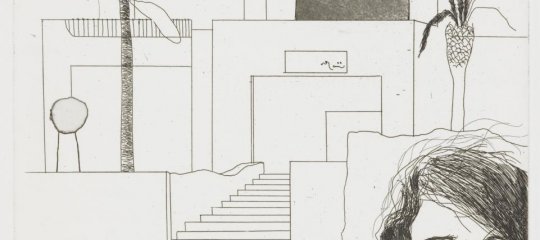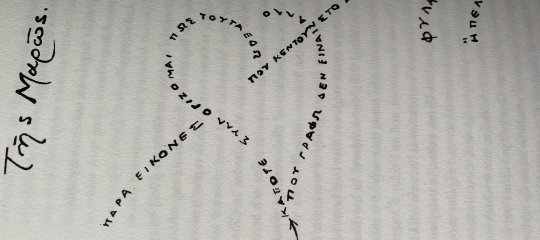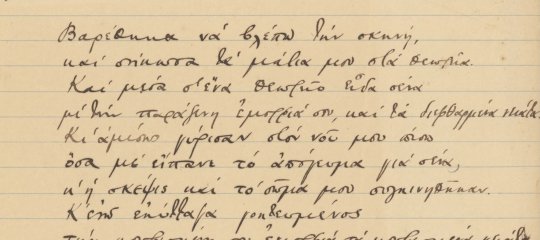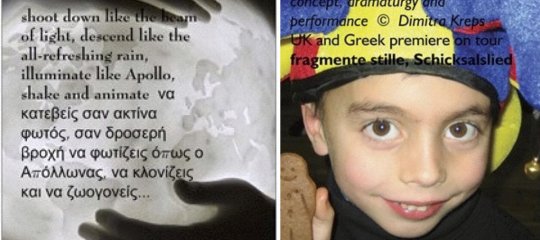Μεταφραστικοί Πειραματισμοί
sissiatha writes, "Στο τμήμα ενηλίκων στο οποίο διδάσκω, εκτός του πανεπιστημίου, επικρατεί ένας μεταφραστικός οργασμός. Από τον οδηγό εξετάσεων του ΚΕΓ, μέχρι το σενάριο για τισ "νύφες" της Ι.Καρυστιάννη κι από γελοιογραφίες μέχρι άρθρα επικαιρότητας, όλα τίθενται στη διάθεση των μαθητών κι ο καθένας επιλέγει ό,τι του αρέσει. Το κείμενο που σας στέλνω είναι από αυτά που είχε την καλωσύνη να μας στείλει η κα Μήττα κι ο μεταφραστής του (ερευνητής-γεωφυσικός) είναι κάτοχος του πιστοποιητικού ελληνομάθειας (β΄επίπεδο) κι έχει "ειδικευτεί" σε άρθρα που αφορούν την Αθήνα. Η συζήτηση της συγκεκριμένης μετάφρασης στην τάξη μάς έδωσε την ευκαιρία να συζητήσουμε για νέους όρους, όπως η "διάδραση" καθώς και για το "δια-" ως πρόθημα.
Σίσσυ Αθανασοπούλου "
12 Δεκεμβρίου 2006
Από το παρόν στο παρελθόν
Σε λειτουργία από τις 4 Δεκεμβρίου η «Θόλος» του Ιδρύματος Ελληνικού Πολιτισμού
 Ίδρυμα Μείζονος Ελληνισμού
Ίδρυμα Μείζονος Ελληνισμού
Η «Θόλος» στην οδό Πειραιώς
Αθήνα
Εγκαινιάζεται τη Δευτέρα 4 Δεκεμβρίου, από τον Πρόεδρο της Δημοκρατίας Κάρολο Παπούλια, η «Θόλος» του Ελληνικού Κόσμου, του πολιτιστικού κέντρου του Ιδρύματος Μείζονος Ελληνισμού, στην οδό Πειραιώς 254. Μικροί και μεγάλοι θα μπορούν τώρα να μεταφερθούν 25 αιώνες πίσω και να «ζήσουν», έστω και για λίγο, στην αρχαία Αθήνα...
Η «Θόλος», ένα υπερσύγχρονο θέατρο εικονικής και διαδραστικής πραγματικότητας, είναι χωρητικότητας 132 θέσεων και συνολικής επιφάνειας 2.300 τ.μ. Η κατασκευή της διήρκεσε τρία χρόνια ενώ σε πλήρη λειτουργία θα βρίσκεται από το 2007.
Σύμφωνα με τα Νέα, χάρη στα υπερσύγχρονα τεχνολογικά συστήματα, οι θεατές θα μπορούν περπατήσουν στην αρχαία Αγορά, να βαδίσουν στην οδό των Παναθηναίων, να σταθούν μπροστά στη μεγαλοπρεπή Ποικίλη Στοά, όπου δίδασκε ο Ζήνων, να δουν από κοντά τον ναό του Ηφαίστου και της Αθηνάς με τις πολύχρωμες μετόπες του, να φτάσουν ως το Νομισματοκοπείο και το Πρυτανείο και να γνωρίσουν το πλήθος των μνημείων της πόλης.
Μέσω 12 προβολικών μηχανημάτων και ειδικών στερεοσκοπικών γυαλιών επιτυγχάνεται η πλήρης στερεοσκοπική προβολή στο σύνολο της επιφάνειας της κοίλης ημισφαιρικής οθόνης, ενώ 48 επεξεργαστές με 48GB μνήμη τελειοποιούν το αποτέλεσμα.
Επιπλέον, δύο καινοτομίες διαφοροποιούν τη «Θόλο» από τα υπάρχοντα συστήματα εικονικής πραγματικότητας.
Η πρώτη είναι η διαδραστικότητα, καθώς ο επισκέπτης έχει τη δυνατότητα να επιλέξει όχι μόνο προς τα πού θα κατευθυνθεί και ποια πορεία θα ακολουθήσει, αλλά και να διαμορφώσει εν μέρει την εξέλιξη της προβολής μέσω ειδικού συστήματος πλοήγησης που υπάρχει δίπλα στο κάθισμά του. Η δεύτερη αφορά τη δυνατότητα της Θόλου να ενσωματώνει σε πραγματικό χρόνο διάδραση μεταξύ εικονικών στοιχείων και ηθοποιών.
Dal presente al passato
In funzione da 4 Dicembre la “Cupola” dell’Istituto della Cultura Ellenica
 Istituzione per l’ Ellenismo in tutto il mondo
Istituzione per l’ Ellenismo in tutto il mondo
La “Cupola” di via Pireos
Atene
Inaugurata lunedi 4 dicembre, dal presidente della Repubblica Carolos Papoulias, la “Cupola” del Mondo Ellenico, del centro culturale dell’ "Istituto dell' Ellenismo in tutto il mondo", in via Pireos 254. Piccoli e grandi ora potranno essere portati indietro di 25 secoli e “vivere”, anche se per poco, nell’antica Atene...
La “Cupola”, un modernissimo teatro virtuale e interattiva della realta, ha una capacita di 132 posti a sedere e una superficie complessiva di 2.300 m2. La sua costruzione e durata tre anni ma sara completamente funzionante dal 2007.
Come riportato da “ta Nea” (il quotidiano n.d.T.), grazie a modernissimi sistemi tecnologici, gli spettatori potranno camminare nell’ antico Agora, andare nella via delle Panatenee, soffermarsi dinanzi all’ imponente Stoa Pecile, dove insegno Zenone, vedere da vicino il tempio di Efesto e di Atena con le loro metope policrome, giungere sino alla Zecca ed al Rettorato e conoscere l’enorme mole di reperti della citta.
Attraverso 12 sistemi speciali di proiezioni stereofoniche si e riusciti ad ottenere la totale visione tridimensionale sulla superbie curva dello schermo semisferico, inoltre completano l’opera 48 calcolatori dotati di 48 GB di memoria.
Inoltre, due novita caratterizzano la “Cupola” dagli altri sistemi analoghi di simulazione della realta.
Il primo e L’interazione visto che il visitatore ha la possibilita di selezionare non solo verso dove dirigersi ma anche quale percorso seguire, inoltre puo gestire se vuole lo svolgersi della proiezione attraverso lo stesso che e posto accanto al suo sedile. La seconda e relativa alla possibilita della “Cupola” di incorporare allo stesso tempo l’ interazione degli elementi della simulazione e degli attori.
Traduzione dal greco:Boris Di Fiore
- Εισέλθετε στο σύστημα για να υποβάλετε σχόλια










